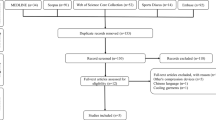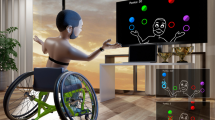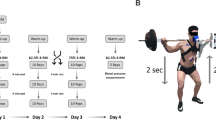Abstract
We have compared wheelchair exercise performed at submaximal levels in a continuous versus discontinuous format. There was a positive linear relationship between heart rate, systolic blood pressure, and VO2 with increasing workload. This was true for both modes of testing with no significant difference in heart rate, systolic blood pressure, VO2, Ve, or Ve/VO2. We conclude that clinical wheelchair exercise testing can be performed in a continuous format without sacrificing physiological data.
Similar content being viewed by others
Log in or create a free account to read this content
Gain free access to this article, as well as selected content from this journal and more on nature.com
or
References
Astrand, P O (1976). Quantification of exercise capability and evaluation of physical capacity in man. Prog. Cardiovasc. Dis., 19, 51–67.
Committee on Exercise, American Heart Association Monograph. Exercise Testing and Training of Individuals with Heart Disease or at High Risk for its Development : A Handbook for Physicians 1975.
Debusk, R F, Houston, N, Haskell, W, Fry, G & Parker, M (1979). Exercise training soon after myocardial infarction. Am. J. Cardiol., 44, 1223–1229.
Dreisinger, T E (1978). A training study. Doctoral thesis. University of Missouri.
Dreisinger, T E & Londeree, B R (1982). Wheelchair Exercise: A review. Paraplegia, 20, 20–34.
Ellestad, M H & Wan, M K C (C.). Predicitive implications of stress testing. Follow-up of 2700 subjects after maximum treadmill stress testing. Circ, 51, 363–369.
Glaser, R M, Foley, D M, Laubach, L L, Sawka, M N & Suryaprasad, A G (1978-79). An exercise test to evaluate fitness for wheelchair activity. Paraplegia, 16, 341–349.
Glaser, R M, Sawka, M N, Brune, M F & Wilde, S W (1980). Physiological responses to maximal effort wheelchair and arm crank ergometry. J. Appl. Physiol: Respirat. Environ. Exercise Physiol., 48, 1060–1064.
Goldschlager, N (1982). Use of the treadmill test in the diagnosis of coronary artery disease in patients with chest pain. Ann. Int. Med., 97, 383–388.
Hrubec, Z & Ryder, R A (1979). Report to the Veterans’ Administration Department of Medicine and Surgery on Service-Connected Traumatic Limb Amputations and Subsequent Mortality from Cardiovascular Disease and Other Causes of Death. U.S. Committee on Veterans Affairs U.S. Senate, U.S. Government Printing Office.
Sawka, M N, Glaser, R M, Laubach, L L, Al-Samkari, O & Suryaprasad, A G (1981). Wheelchair exercise performance of the young, middle aged, and elderly. J. Appl. Physiol.: Respirat. Environ. Exercise Physiol., 50, 824–828.
Whiting, R B, Dreisinger, T E & Abbott, C The clinical value of exercise testing in handicapped subjects. Southern Medical Journal (in press).
Wicks, J R, Lymburner, K, Dinsdale, S M & Jones, N L (1977/78). The use of multistage exercise testing with wheelchair ergometry and arm cranking in subjects with spinal cord lesions. Paraplegia, 15, 252–261.
Author information
Authors and Affiliations
Rights and permissions
About this article
Cite this article
Whiting, R., Dreisinger, T. & Hayden, C. Wheelchair exercise testing: comparison of continuous and discontinuous exercise. Spinal Cord 22, 92–98 (1984). https://doi.org/10.1038/sc.1984.17
Issue date:
DOI: https://doi.org/10.1038/sc.1984.17



